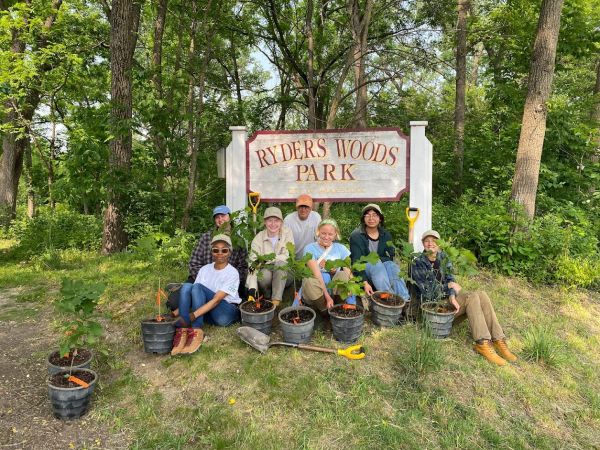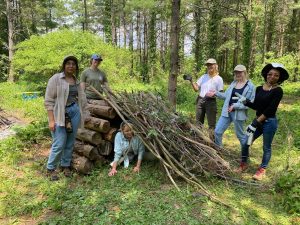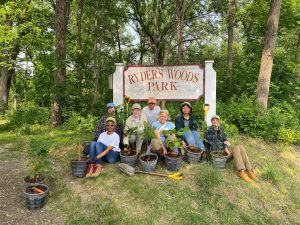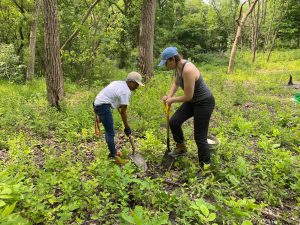
CLIP 2023 is Underway!
by Emma Klein
Welcome to the first week of TLC’s 2023 Conservation Leader Internship Program! This week’s update is provided by CLIP’s 2023 crew leader, Emma. This year is our program’s largest crew size yet, and I am eager to embark on this journey with the other six CLIPsters.
Our first day at CLIP started on Thursday, where we were introduced to herbicide preparation, GIS collector tools, and invasive plant identification. These skills will be needed for the rest of the summer as we complete restoration projects and workdays at TLC sites.
 We then traveled to Ryders Woods where Megan Oropeza, TLC’s restoration ecologist, was hosting a tree-identification nature walk. Here, Megan demonstrated how to utilize a tree’s leaf arrangement, bark texture and bud shape (among other characteristics) to identify its species. On our walk, we identified a variety of trees, such as slippery elm (Ulmus fulva), shagbark hickory (Carya ovata), and northern catalpa (Catalpa speciosa). Many of these are species we protect during conservation workdays. Before leaving Ryders Woods, we grabbed samples of garlic mustard and honeysuckle to add to our identification journals. We ended the day with a CLIP-tradition, team-building exercise, which involved working together to craft a structure out of materials within Hennen. Our group opted for a small, ornately decorated lean-to.
We then traveled to Ryders Woods where Megan Oropeza, TLC’s restoration ecologist, was hosting a tree-identification nature walk. Here, Megan demonstrated how to utilize a tree’s leaf arrangement, bark texture and bud shape (among other characteristics) to identify its species. On our walk, we identified a variety of trees, such as slippery elm (Ulmus fulva), shagbark hickory (Carya ovata), and northern catalpa (Catalpa speciosa). Many of these are species we protect during conservation workdays. Before leaving Ryders Woods, we grabbed samples of garlic mustard and honeysuckle to add to our identification journals. We ended the day with a CLIP-tradition, team-building exercise, which involved working together to craft a structure out of materials within Hennen. Our group opted for a small, ornately decorated lean-to. 
On Friday, we tackled our first large-scale area of invasives: an acre-sized clump of reed canary grass (RCG) at Crowley Sedge Meadow. The CLIP team was able to practice their herbicide application methods in the field, as well as their transecting technique. Effectively eradicating such a large area requires teamwork, organization and communication. Without the disturbances caused by RCG, this wetland will hopefully host a healthy abundance of native forbs, sedges, and grasses in the future. During lunch, Megan took us on another nature walk through a neighboring easement, where we saw Jack-in-the-pulpit (Arisaema triphyllum), marginal shield fern (Dryopteris marginalis), and American jumpseed (Persicaria virginiana).
After a restful weekend, the CLIPsters kicked off the week with their first project: Project Quercus. This event, led by Dave Zeiger, focuses on restoring local landscapes to their original oak-dominated environments, one tree at a time. After a quick tutorial by Dave, we were able to plant 10 bur oak saplings in a region previously dominated by woody invasives.



The following day, we began our summer-long research projects. We will be studying the effect of microbial diversity on plant growth, testing specifically brown-eyed susans (Rudbeckia triloba). Additionally, we want to explore the effect of adding mycorrhizae mix to our host soil. To set up this experiment, we collected several soil core samples from Irish Oaks and prepared a microbial gradient using decreasing ratios of depleted field soil. The plant subjects will be cared for and observed over the course of the summer.
 On Thursday, the CLIPsters shared their first workday. We traveled to Tryon Grove to continue clearing an area that TLC and their volunteer crew had been improving over previous weeks. Everyone was able to practice their brushsaw skills, as well as cut-stump herbicide application. After clearing nearly 500 square meters of bittersweet, we celebrated by pulling invasive garlic mustard and dame’s rocket. Here, Kim took the opportunity to show us jewelweed (Impatiens capensis) and stinging nettle (Urtica dioica), both of which can be made into herbal medicine.
On Thursday, the CLIPsters shared their first workday. We traveled to Tryon Grove to continue clearing an area that TLC and their volunteer crew had been improving over previous weeks. Everyone was able to practice their brushsaw skills, as well as cut-stump herbicide application. After clearing nearly 500 square meters of bittersweet, we celebrated by pulling invasive garlic mustard and dame’s rocket. Here, Kim took the opportunity to show us jewelweed (Impatiens capensis) and stinging nettle (Urtica dioica), both of which can be made into herbal medicine.
We finished the second week at TLC with a full day of seed collection. We spent the morning at Westwood collecting yellow star grass (Hypoxis hirsuta) seed. This seed is very small and can be tricky to locate, but luckily it was plentiful at this site. For lunch, we got to meet with CLIPsters from previous years, where they bestowed some sage advice: make connections and drink water! After lunch, we traveled to Prairie Ridge to collect the last bit of marsh marigold (Caltha palustris) seed. We had been visiting this site all week for marsh marigold, and by the end had accumulated several dozen bags of seed to dry.
grass (Hypoxis hirsuta) seed. This seed is very small and can be tricky to locate, but luckily it was plentiful at this site. For lunch, we got to meet with CLIPsters from previous years, where they bestowed some sage advice: make connections and drink water! After lunch, we traveled to Prairie Ridge to collect the last bit of marsh marigold (Caltha palustris) seed. We had been visiting this site all week for marsh marigold, and by the end had accumulated several dozen bags of seed to dry.
This week has been incredibly fun and busy. The CLIP team has encountered a lot of new beginnings in just seven days, and we are excited for a summer packed with unique experiences and opportunities!